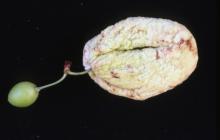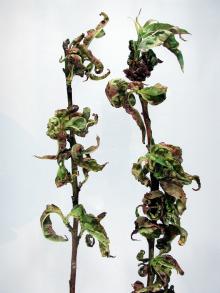See:
Peach (Prunus persica) - Leaf Curl
Cause Taphrina pruni, a fungus that overwinters on old diseased fruits clinging to the tree or on the ground. Infection of leaves, shoots and fruit occurs in wet, cool weather when buds break in the spring. Infections are more prevalent on fruit than on leaves or shoots. The disease seldom occurs and has not caused economic loss.
The fungus T. pruni-subcordatae causes a witches' broom of escaped prunes along fence rows and of Pacific plum (P. subcordata). Common in the Willamette Valley of Oregon.
Symptoms Twigs, small branches, and young leaves often are distorted and swollen. Some leaves may have a yellow or red cast. Infected fruit is particularly striking: swollen, bladder-like, often yellowish at first, and later becoming dark brown to black. Before drying and mummifying, it is soft, puffed up, and somewhat hollow and spongy.
Witches' brooms arise from thicken or swollen branches that produce numerous shortened shoots. Leaves are thick and curled early in the season but leaves produced later are normal. Fruits are normal.
Cultural control
- Prune out all infected twigs, limbs, and/or brooms.
Chemical control Spray during the winter dormant season.
- Bordeaux 12-12-100. O
- Lime Sulfur Ultra (27% lime sulfur) at 2 to 3 gal/100 gal water. 48-hr reentry. O
- Rex Lime Sulfur Solution (28%) at 6 to 12 gal/100 gal water. 48-hr reentry. O
Reference Heinis, J. 1960. Taphrina pruni-subcordatae (Zeller) Mix, causing witches'-broom on Italian and French prunes. Plant Disease Reporter 44:830-831.


